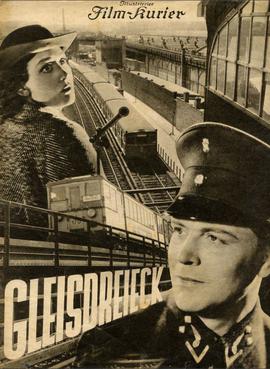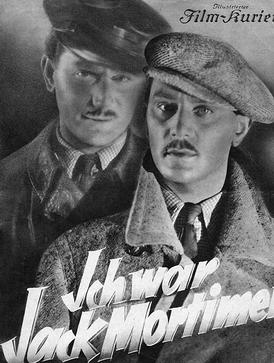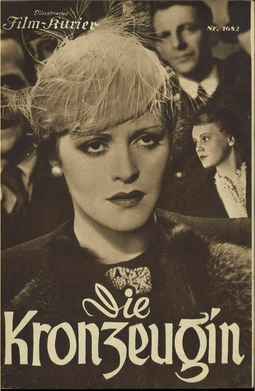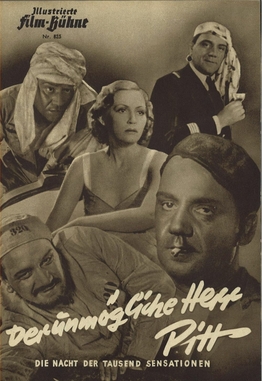In the Jungle of Cities is a play by the German modernist playwright Bertolt Brecht. Written between 1921 and 1924, it received its first theatrical production under the title Im Dickicht at the Residenztheater in Munich, opening on 9 May 1923. This production was directed by Erich Engel, with set design by Caspar Neher. The cast included Otto Wernicke as Shlink the lumber dealer, Erwin Faber as George Garga, and Maria Koppenhöfer as his sister Mary. Im Dickicht was produced at Max Reinhardt's Deutsches Theater in Berlin, where Brecht had been employed as a dramaturg. The production opened on 29 October 1924, with the same director and scenographer, but in a cut version with a new prologue and the title Dickicht: Untergang einer Familie. Fritz Kortner played Shlink and Walter Frank played George, with Franziska Kinz, Paul Bildt, Mathias Wieman, and Gerda Müller also in the cast. Willett and Manheim report that this production "was not a success".

Highway Dragnet is a 1954 American film noir B film crime film directed by Nathan Juran from a story by U.S. Andersen and Roger Corman. The film stars Richard Conte, Joan Bennett and Wanda Hendrix. It was Roger Corman's first feature film credit. Corman also worked as an associate producer.

Friedemann Bach is a 1941 German historical drama film directed by Traugott Müller and starring Gustaf Gründgens, Leny Marenbach and Johannes Riemann. The film depicts the life of Johann Sebastian Bach's son Wilhelm Friedemann Bach. It is based on Albert Emil Brachvogel's novel Friedemann Bach. Wilhelm Friedemann Bach is shown as a gifted son trying to escape his father's shadow.
Artisten is a German circus movie from 1934 to 1935 starring Susi Lanner, Hans Junkermann, Hilde Hildebrand and Harry Piel, who also acted as director. The screenplay was written by Max W. Kimmich after the silent movie The secret of the circus Barré.

The Ruler is a 1937 German drama film directed by Veit Harlan. It was adapted from the play of the same name by Gerhart Hauptmann. Erwin Leiser calls it a propagandistic demonstration of the Führerprinzip of Nazi Germany. The film's sets were designed by the art director Robert Herlth. Location shooting took place around Oberhausen and Pompeii near Naples. It premiered at the Ufa-Palast am Zoo in Berlin.
For Eyes Only is an East German espionage film. It was released in 1963.

Hitlerjunge Quex,, is a 1933 German film directed by Hans Steinhoff, based on the similarly named 1932 novel Der Hitlerjunge Quex by Karl Aloys Schenzinger. It was released in the United States as Our Flag Leads Us Forward.

Emil and the Detectives is a 1964 American crime comedy film directed by Peter Tewksbury based on the novel Emil and the Detectives by German author Erich Kästner. The film stars Walter Slezak and Bryan Russell.

Friedrich Panzinger was a German SS officer during the Nazi era. He served as the head of the Reich Security Main Office (RSHA) Amt IV A, from September 1943 to May 1944 and the commanding officer of three sub-group Einsatzkommando of Einsatzgruppen A in the Baltic States and Belarus. From 15 August 1944 forward, he was chief of RSHA Amt V, the Kriminalpolizei. After the war, Panzinger was arrested in 1946 and imprisoned by the Soviet Union for being a war criminal. Released in 1955, he was a member of the Bundesnachrichtendienst. In 1959, Panzinger committed suicide in his jail cell after being arrested for war crimes.

Confess, Doctor Corda is a 1958 West German crime film directed by Josef von Báky and starring Hardy Krüger, Elisabeth Müller and Lucie Mannheim. It is considered to be a film noir, one of a number made in Germany during the decade. It was shot at the Spandau Studios. The film's sets were designed by the art directors Erich Kettelhut and Helmut Nentwig.

Roses for the Prosecutor is a 1959 West German comedy film with tragical and critical elements, directed by Wolfgang Staudte and starring Martin Held, Walter Giller and Ingrid van Bergen. It was one of the few German movies of the 1950s which openly addressed the German Nazi era.

Dangerous Crossing or Rail Triangle is a 1937 German crime film directed by Robert A. Stemmle and starring Gustav Fröhlich, Heli Finkenzeller, and Paul Hoffmann. It is set amongst railway workers and takes its name from Gleisdreieck on the Berlin U-Bahn. It was partly shot at the Babelsberg Studios in Potsdam. The film's sets were designed by the art directors Carl Böhm and Erich Czerwonski. It was shot on location around Berlin. It premiered at the city's Ufa-Palast am Zoo.

I Was Jack Mortimer is a 1935 German thriller film directed by Carl Froelich and starring Anton Walbrook, Eugen Klöpfer, and Sybille Schmitz. It was shot at the Tempelhof Studios in Berlin. The film's sets were designed by the art director Franz Schroedter. It is an adaptation of the 1933 novel of the same title by Alexander Lernet-Holenia.

The Island is a 1934 German thriller film directed by Hans Steinhoff and starring Brigitte Helm, Willy Fritsch and Hubert von Meyerinck. The film's sets were designed by the art directors Artur Günther and Benno von Arent. Location shooting took place on the coast of Dalmatia. It premiered at the Ufa-Palast am Zoo in Berlin in August 1934. A separate French version Vers l'abîme was also released.

The Merciful Lie is a 1939 German drama film directed by Werner Klingler and starring Hilde Krahl, Elisabeth Flickenschildt and Ernst von Klipstein. It was shot at the Johannisthal Studios in Berlin and on location in Bremen. The film's sets were designed by the art directors Karl Böhm and Erich Czerwonski.

The Chief Witness is a 1937 German crime drama film directed by Georg Jacoby and starring Iván Petrovich, Sybille Schmitz and Sabine Peters. It was shot at the Babelsberg Studios in Berlin. The film's sets were designed by the art directors Otto Hunte and Willy Schiller. Location shooting took place in the Krkonose Mountains in Czechoslovakia and Zugspitze in Bavaria.

The Impossible Mister Pitt is a 1938 German adventure crime film directed by and starring Harry Piel. It also features Willi Schur, Leopold von Ledebur and Hilde Weissner. It was shot at the Babelsberg Studios in Berlin and on location off the coast of Split in Croatia. The film's sets were designed by the art directors Otto Erdmann and Hans Sohnle. It was based on the novel of the same title by Georg Mühlen-Schulte who also worked on the screenplay.

A Man and His Dog is a 1918 narrative by Thomas Mann. It describes the adventures of the narrator with his dog Bauschan (Bashan) in the nature surrounding the author's home in Munich. It was written in the twilight of World War I and portrays an idealised and timeless world.















